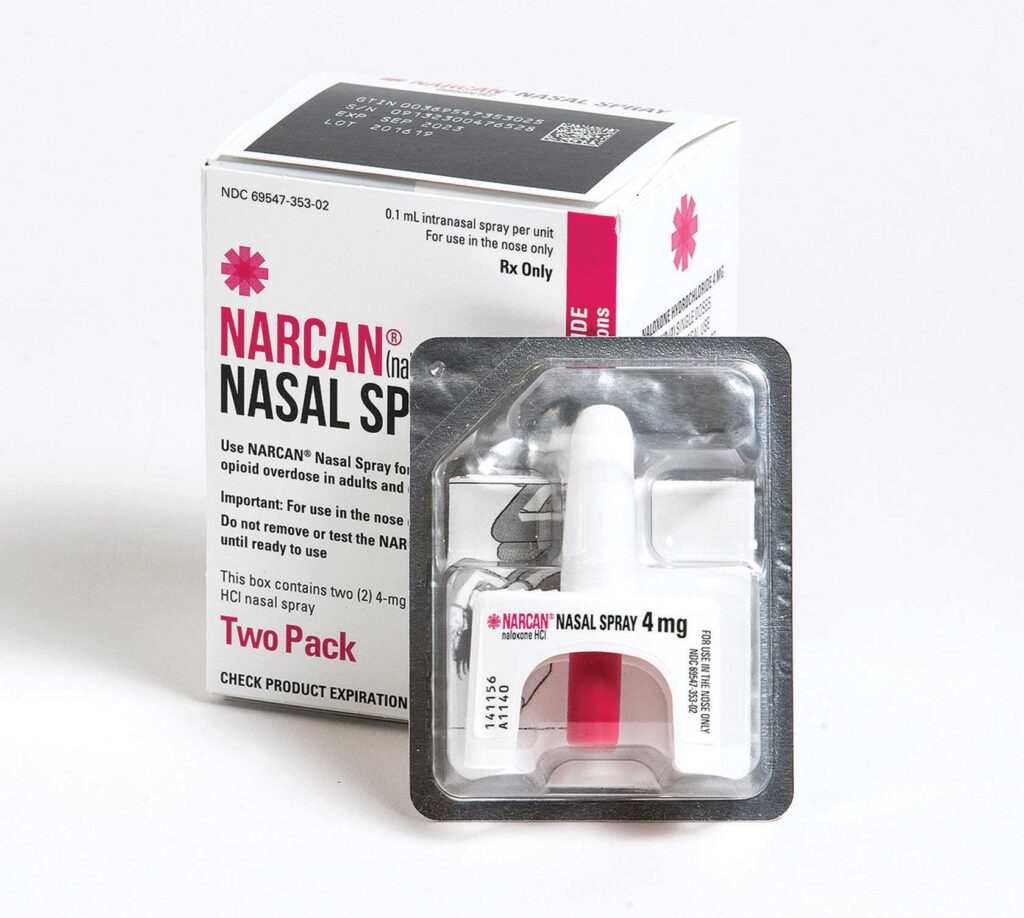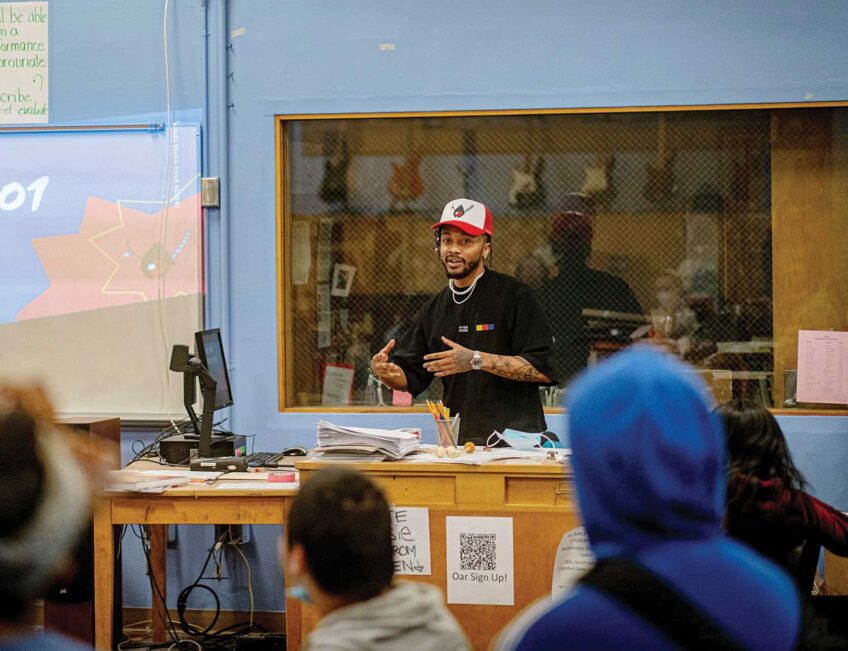Study finds more laypeople are administering overdose reversal medication
Shift could be one element driving decrease in overdose deaths in Boston and nationwide

The city, state and country have announced decreases in opioid overdose deaths in recent months. One element that might be contributing to that decline: getting more medications that reverse overdoses into the hands of everyday people.
At the start of October, the Boston Public Health Commission announced that opioid overdose deaths in the first four months of 2024 decreased by 33% compared to the first four months of 2023. Over the summer, state data released by the state Department of Public Health found a 10% decrease statewide in 2023 overall — the largest single-year drop since 2010.
Those numbers follow a national trend too. In May, the Centers for Disease Control and Prevention announced that across the United States, 2023 saw the first decline in overdose deaths since 2018.
One factor that could be supporting that decline is increased access to naloxone, a drug that rapidly reverses the effects of an overdose.
“When people are using [opioids], they sometimes use among friends, they use in groups, so they are the first ones who are going to see someone overdosing right away. They are able to use [naloxone] and reverse overdose before someone calls 911,” said Cyril Ubiem, senior vice president of programs and services at Harvard Street Neighborhood Health Center in Dorchester, which does work to connect community members to the drug.
Access to naloxone by laypeople can help get the medication to more people more quickly.
“For a victim that’s experiencing an overdose, they can’t treat themselves. We have to get naloxone out into the community so those that are around them are able to take action,” said Rebecca Cash, an assistant professor of emergency medicine at Harvard Medical School and Massachusetts General Hospital.
Increasing access to the drug has been a priority for the city of Boston in recent years, as it aims to address the impacts of the opioid epidemic in the city. And in the summer of 2023, Narcan, a brand-name nasal spray version of the drug, first became accessible over the counter in pharmacies nationwide, a shift that supporters said has been heralded as a key step to addressing the opioid epidemic (Massachusetts had previously made the drug available without a prescription in the state in 2022).
Some signs indicate efforts like the ones in Boston could be helping.
New research, published last month in the Journal of the American Medical Association, found a rising number overdoses have been treated by laypeople administering naloxone. That study, by Cash, among a team of other researchers, found that instances of naloxone being administered by laypeople before the arrival of emergency medical services increased by 43.5% from June 2020 to June 2022.
“I think the main message of this paper is a lot of these programs that we have going on for layperson naloxone seem to be at least improving the access and the use of it by laypeople,” she said.
To explore the trends, the researchers used a national dataset of emergency medical services reports and considered the number of patients who received naloxone overall, and how many were reported to have received it before EMS arrived.
That study has some limitations, Cash said, many of which stem from general challenges around evaluating the effectiveness of programs promoting public access to naloxone.
Tracking how much naloxone is being given out is easier than tracking how many people are administering it. The EMS data used by Cash and the other researchers offers one window into usage but doesn’t cover all cases. For example, instances in which someone administers naloxone to someone experiencing an overdose but doesn’t call 911 won’t be included.
That gap in information can make developing efforts to address the opioid epidemic more complicated.
“We know that the overdose deaths are going down … but it’s still like, ‘Well, what’s working?’” Cash said. “If we can figure out what’s working, then we can keep doing that.”
A spokesperson for the Boston Public Health Commission, too, acknowledged that its ability to track actual use of the drug is limited, but said that it views increased availability as a positive outcome in itself.
And the research can’t point specifically to what efforts are helping getting naloxone into people’s hands or if that is driving the downward trend.
But a spokesperson for the health commission pointed to a 2013 study that found in 19 communities across the Massachusetts where researchers taught opioid users, social service agency staff, and friends and family of opioid users how to administer nasal naloxone, those cities and towns saw decreases in the rate of opioid overdose deaths.
“While BPHC continues to evaluate the relationship between the naloxone access and recent decrease in overdoses, it’s fact that naloxone saves many lives per day in Boston,” the spokesperson said. “The distribution and increased access can only be helping the situation.”
Across Boston, increasing access to naloxone for free has been a priority, with a number of efforts from the Boston Public Health Commission working to directly get naloxone to community members or to distribute the drug to community organizations to increase access.
In July, the health commission announced a new public health agenda with a focus on decreasing racial and neighborhood gaps in life expectancy. City data from 2023 found a 23-year gap in life expectancy between a part of Back Bay and an area, about two miles away, near Nubian Square. That agenda, called the Live Long and Well Agenda, aims to tackle the leading causes of premature mortality in the city, which includes unintentional drug overdoses.
In September, it announced five community organization recipients of municipal grant funding, selected to help distribute naloxone, especially to communities at increased risk of overdose.
“By partnering with community organizations, we can fight stigma and increase awareness in our communities,” said Dr. Bisola Ojikutu, executive director of the Boston Public Health Commission, in a statement at the time.
Other local efforts, too, are making it easier for everyday people to be able to administer naloxone. In July, the MBTA announced a Public Access Naloxone pilot at five stops along the Red Line, with cabinets containing Narcan at Quincy Center, Ashmont, Andrew, South Station, and Harvard stations.
Harvard Street Neighborhood Health Center was one of the city’s grant recipients, receiving funding in September to increase access to naloxone and other services aimed at reducing opioid overdoses.
That funding effort also includes conversations around installing a kiosk at the center to house naloxone and other prevention materials. In September, the Public Health Commission announced a similar stand in the lobby of its headquarters at 1010 Massachusetts Ave, with free access to naloxone and drug testing strips. A BPHC spokesperson said the kiosks are part of a variety of ways the commission is aiming to increase access to naloxone.
“You can have a naloxone, you can have Narcan, all the prevention materials, so that when people can come in, just pick them up and have them,” Ubiem said. “Having that available to everybody means overdoses can be reversed immediately [in] the community.”
The response is a “multimodal approach,” he said, with efforts to increase access to naloxone while also hiring a community outreach worker to meet with people on the street, both to distribute medications to reverse the effects of an overdose or ease cravings and to connect individuals with treatment programs.
“You can’t just tell someone to just quit drugs right now, and then they’ll quit; they have to come to a point when they make up their mind,” Ubiem said. “While in the process of making up their mind, they have the tools to stay alive and to engage in treatment.”






